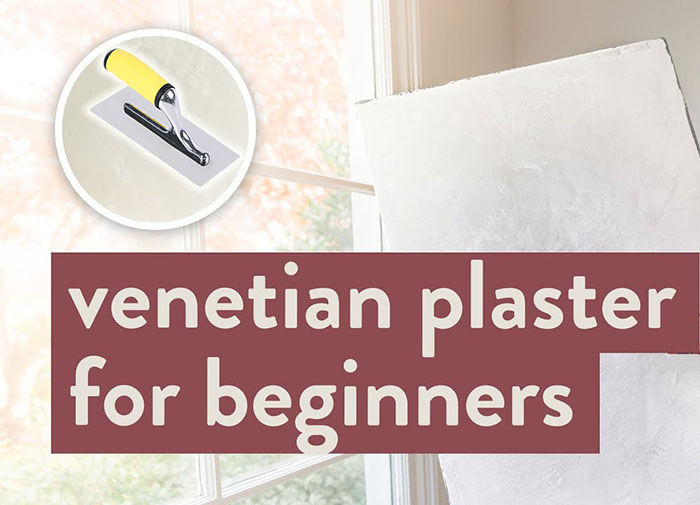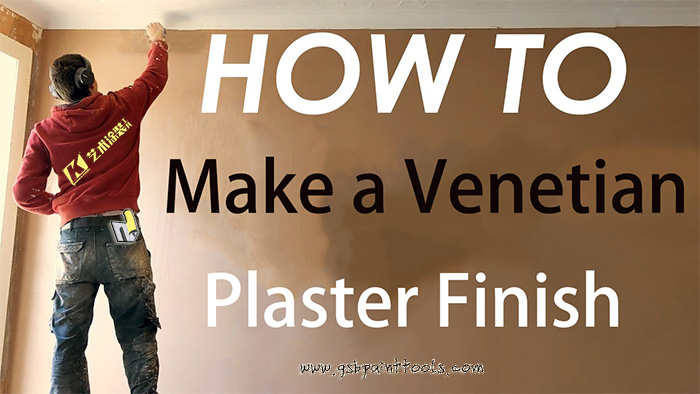Originally used as a décor for Roman palaces, Venetian plaster gradually became the standard material for both residential and formal architecture. Using Venetian plaster is a great way to decorate both interior and exterior walls. It is more durable than paint, looks great, comes in various colors and is a popular way to decorate.
Venetian plaster is made out of limestone, ground marble dust and natural or artificial pigment. Faux Venetian plaster is made out of acrylic and natural or artificial pigment. It is meant to replicate Scagliola, which is an Italian plaster technique that has been used for hundreds of years. This technique resulted in a product that felt and looked like real marble.
Availability Authentic Venetian plaster recipes are handed down from generation to generation, within Italian artisans and craftsmen. This means that there are very few people that can manufacture authentic Venetian plaster. Because it is hard to come by, faux Venetian plaster is often used in place of the original lime blend.
Cost True Venetian plaster is made up of at least 40% marble dust and expensive pigment, making authentic Venetian plaster very expensive. Add to that the limited availability, which also creates a high cost, making faux Venetian plaster an option for many homeowners.
Application Technique The traditional method of applying Venetian plaster is to apply it layer after layer with a trowel and then polishing it to provide an illusion of texture and depth. The plaster must dry thoroughly between each layer. The wall must be completely smooth prior to beginning the application process. Faux Venetian plaster is applied with a spatula. Both materials can be sanded smooth to look like marble, or have texture to look like stone.
Installation Time The traditional Venetian plaster process is very timely, because it requires so many layers, with long periods in between each layer to allow the plaster to dry thoroughly. Faux Venetian plaster can be put up in a fraction of the time.
Durability Faux Venetian plaster is basically a thin coating, up to about three layers, of tinted plaster. True Venetian plaster is done in many, many layers, thus it is thicker and does not damage easily. Faux Venetian plaster is kept as an inside wall treatment whereas true Venetian plaster can be used on interior and exterior walls because it is much thicker and more durable.
Faux Venetian plaster is an artful way to decorate both interior and exterior surfaces. It imparts old world charm, discrete sophistication and a look of elegance. At the same time, it does not have the high cost, long instillation time or contain lime.

Venetian plaster is not technically a kind of plaster. It is merely a term used mostly by American architects and interior designers to this kind of technique of decorating walls. While plaster is primarily made of gypsum, Venetian plaster is more of a stucco kind of material composed traditionally of sand and lime or hydraulic lime, although modern techniques combine this with cement as well.
Most people admire the edgy simplicity of Venetian plaster on walls. Some say they can be a work of art by themselves, decorating the wall as wallpaper might. Nowadays it is no longer needed to mix your own Venetian plaster with lime or hydraulic lime and sand.
You will find many varieties of pre-made Venetian plaster in the paint section of your neighborhood home improvement store or center. They will usually come in cans or buckets, pretty much the same way that paint is sold as well. They will all come in different colors to suit your home decoration needs, although there are some varieties that will be sold without any color yet, and it's up to you to mix in your desired color for a more personalized feel.
Venetian plaster is an easy, do it yourself way to bring some texture and color to an otherwise drab and lifeless wall. Because today there are ready-made Venetian plaster mixes that are commercially available, anyone can add a touch of class to their home with Venetian plaster.
The age-old surface treatment of Venetian plaster is making a comeback in modern homes. Mostly used on interior walls or ceilings, it mimics the multi-toned, three-dimensional effect of natural stone—without the need for lugging and installing heavy slabs of real marble or limestone.
Homeowners can recreate the old-world look in three ways: with a lookalike homemade finish, store-bought synthetic Venetian plaster paint, or authentic lime Venetian plaster. Read on to find out which of these applications is right for you, and then learn how to apply a Venetian plaster finish in your home.
The Venetian Plaster Look Originating in Venice, Italy, Venetian plaster gained widespread popularity in the Roman Empire as a means to imitate natural stone surfaces inside of palazzos, villas, and cathedrals. Artisans would blend lime plaster with marble dust and pigments to create the compound Venetian plaster, then trowel it onto walls or ceilings in multiple thin layers with short, overlapping strokes.
Professional painters still use this authentic method today, but most do-it-yourselfers choose to mimic the look with either a homemade plaster finish of tinted joint compound and tinted glaze or ready-to-apply cans of synthetic paint formulated to look like Venetian plaster. Whatever method you choose for the interior walls and ceilings in living rooms, bedrooms, and bathrooms, you’re sure to end up with the luxurious look of natural stone without the expensive and cumbersome installation.
Venetian plaster is a finish made of slaked lime and marble dust. It has many benefits over some more traditional treatments, such as vinyl. Originally most commonly seen in Venice, Italy, during the late 16th century, Venetian plaster has recently become one of the most frequently requested finishes on the market. Below are 5 of the reasons this material is so popular.
1. Versatile:
Venetian plaster is one of the most versatile treatments available. It can be applied to almost any new or pre-existing interior or ceiling, including:
2. Durable:
Venetian plaster dries to a rock-like hardness, making it exceptionally durable. It resists shrinking and also has some flex to it, so it withstands impacts that could cause other finishes to crack. If there ever is an imperfection that needs to be patched, Venetian plaster can be repaired with little cost or effort since it won't require replacing a larger section.
Venetian plaster is among the easiest finishes to maintain. It is distributed in a variety of pre-mixed pigments that last many years without fading. This makes it unnecessary to paint. It also wets and dries very quickly, so even exterior are almost effortless to clean. By allowing water vapor to permeate freely and water to evaporate easily, plaster avoids trapping moisture under the surface, which can be problematic with other finishes, such as vinyl.
3. Timeless:
Venetian plaster is timeless and interchangeable. Even though the pre-mixed coloring eliminates the need to paint, Venetian plaster is an ultra-smooth surface which lends itself easily to modifications. With very little preparation, you can easily transform a room from a nursery into a child's or teen's bedroom, or give your kitchen a quick face lift, to always maintain a fresh appearance in your home.
4. Environmentally-Friendly:
Venetian plaster is one easy way to "go green." The ingredients are all natural and non-toxic, and when applied in a two or three coat veneer, plaster provides an optimal indoor air quality. Lime is also naturally high in PH, so it automatically acts as an antibacterial surface, which inhibits the growth of mold and other fungus. Plaster will also have a positive impact on your energy costs, since it is applied in multiple layers of wood and cement board before the plaster is spread, it is an easy way to add layers of insulation to your home, making your furnace and air conditioner more efficient.

Venetian Plaster Finishes Techniques
Venetian plaster covers the whole range of decorative. plaster finishes from the very highly polished Venetian plaster to the rugged look of textured polished plasters. When Venetian plaster applied perfectly, can be used to create a highly polished. Rock-hard, marble-like finish. Venetian plasters can be used on the surfaces where the marbles slab couldn’t be installed easily. It is made up of fired limestone and water, that creates the lime plaster. And when it applies to the wall, comes in contact with the carbon dioxide and turns to rock-solid limestone again.
About the Venetian Plaster:
Ancient coating in modern words describes the Venetian plaster coating. It is well achieved through the tools used by the skilled craftsmanship. Modern tools and techniques allow you to create the same result by yourself. New products nowadays contain acrylic polymers which are more durable and leaves long-lasting surfaces.
Tools:
300-600 grit sandpaper
Venetian plaster
Steel or hard plastic trowel
Apart from the above-mentioned basic requirements, you will be in need of some other tools:
Eye goggles
Brush
Primer
Roller
Gloves
Universal color
Drop cloth
Have a little experience with Venetian plaster:
Some people remain in a disillusionment that they know painting and can to do Venetian plaster. For the kind information. It’s totally different as in binary opposite. Just to avoid any miscalculation buy a couple of sheets of drywall and spent practicing with the material to gain confidence and some good skills. Start creating new texture by yourself.
Formulate the room:
Try to formulate the room as much as possible to make it spacious. Then spread the large piece of drop cloth on the ground floor which would stop plaster to touch the ground. If you find any types-of-crack or hole in the wall, fill it with filling or sand. Any type of grease can be removed with the help of sandpaper.
Try to wear gloves and eyeglasses because the plaster can cause skin itching while the particles may enter into your eyes cause loss of eyesight. Last but not the least mix Venetian plaster thoroughly before every utilization.
Apply the first coat:
Nowadays tint has already been added to the Venetian plaster which directly can be used. Preferably starts from the corner of the room if you are the beginner at it. Apply the plaster by using the trowel. And try to spread the plaster at varying area and angles at each stroke.
Second coat to be applied:
While applying the second coat to the wall, the same color of Venetian plaster shall be used. Hold the trowel at the angle which would help you to move the trowel in overlapping process. Always apply a thin layer of plaster while the second coating. To be precise, if there is any void or spot clean it by using plaster after filling. Leave the whole plaster at least for a whole day before giving the final touch.
Final touchstone:
Final processing of the Venetian plaster method is to brush the surface and applying a topcoat. If your room reserves a high quantity of moisture then the top coat is highly recommendable, which would add the durability to the surface. In order to burnish, one can use a fine sandpaper using it in the circular motion. When topcoat is applied it looks quite darken in color, can be removed on burnishing the surface again.
There are several huge benefits of Venetian plasters, which would be the biggest reason that compels it to use in your house:
It absorbs Carbon Dioxide
It regulates the humidity
It prevents mould
It can be clean easily
It contains no toxins or gases.

How to Make a Venetian Plaster Finish Step by Step
Step 1:
Before you can do any Venetian finishing, thoroughly clean the walls. Wipe down every inch of the surface with warm water and soap. If your walls have a high glossy finish, sand them lightly with the find grit sandpaper. Your goal is to dull the finish.
After sanding the wall, vacuum the dust and rewash the wall. Do not soak the surface, but use a moist towel or sponge to wipe it down until clean.
Step 2:
Holding the trowel at a 20- to 30-degree angle, apply the first coat of Venetian plaster. Start with a small amount of plaster in one spot, and then spread it around in a wide, circular motion. Use a small amount of plaster to make a very thin coat. Cover the entire wall with a thin coating.
Every few minutes, wipe the trowel of any dried pieces of plaster. This could cause scratching in the wall as you swipe the trowel with each new pass.
Step 3:
Allow the first coast of plaster to dry for at least 4 hours. Look for the plaster to lighten as a sign that it is thoroughly dry.
Step 4:
This time holding the trowel at a 90-degree angle, apply a second coast of Venetian plaster finish. Instead of the big sweeping movements as with the first coat, keep the movements of the trowel to smaller circles.
Fill in any missed areas, and push harder with the trowel for a smoother finish. Allow this coat to dry for only an hour. If you let it sit any longer than that, the finish will be harder to polish.
Step 5:
Burnish with a trowel. Push hard and rub the plaster in tight small-to-medium circles. The harder you push on the trowel, the more of a gloss you will get on the finish. Keep an even pressure, though. Do not press too hard on one side and not on the others. Wipe down the entire wall after you have finished burnishing the second coat. Use a moist cloth to get rid of any dust or other particles.
Step 6:
Apply a protective top coat with the trowel. Spread out evenly in a thin coating. Keeping even pressure on the trowel, press hard for a nice smooth finish.
About Venetian Plastering Trowel
Let’s take a look at the most important specialist tool needed for Marble plastering: The Venetian Plastering Trowel
The trowel is the tool that makes the polished plaster “alive”, it’s needed for the application of all the coats and the burnishing; without it, creating stone or marble like finishes would be impossible.
Basic attributes:
What makes the Venetian plastering trowel suitable for marble plastering? The most important quality is the quality of the steel and the most important technical features are the rounded edges and corners. These attributes enable the creation of smooth, glossy or stone-like finishes without scratching the surface as an ordinary plastering trowel would. Some trowels have to be broken in but the highest quality Italian trowels like K brand can be used straight away.

Sizes and material:
Venetian trowels come in different shapes, sizes and with different handles, but all have to be flexible, durable and perfectly smooth. The most common blade form is the trapezoidal and the most common sizes are the 200mm x 80 mm, the 240mm x 100mm and the 280mm x 120mm…etc. Every applicator needs the smallest 200mm size but larger areas require larger trowels. For some great examples see the K brand venetian plastering trowel selection at G.SB.
Most good manufacturers also offer different blade thicknesses. Why is this important? The standard 0.6mm thickness is already flexible but some prefer 0.5 or even 0.4mm thickness because they are more flexible. The thinnest, 0.3mm Japanese trowel is only used for special applications of Stucco (high-gloss acrylic Venetian plaster) or (lime-based polished plaster). The right blade thickness and thereby flexibility makes your job much easier!
The trowel should be of the highest quality stainless steel, completely rust-free. Some are hand welded and carefully tested, these can be your faithful companions for 12or 22 years. The handle can be made of wood or plastic, the latter is usually better suited for large areas because of the easier grip but eventually which handle an applicator uses is based on his personal preference.
Maintenance:
Some trowels have edge protectors which should always be on if you aren’t using your trowel, especially for transportation. If you work with polished plasters, the edge of the trowel should be as sharp as possible as any imperfections scratch the surface thereby destroying the beauty of the Venetian plaster.
To maintain the required sharp, clear edge, get different grit size sandpapers. First, smoothen every edge with 550 and then go gradually up to 1600. Generally, you should use wet or dry sandpaper as it’s more efficient.
Previous: K Brand Drywall Skimming Blade Review 2022
Next: How Acrylic Fabrication Will Improve Your Visual Merchandising
Copyright:@2020-2021
Comments Please sign in or sign up to post.
0
0 of 500 characters used